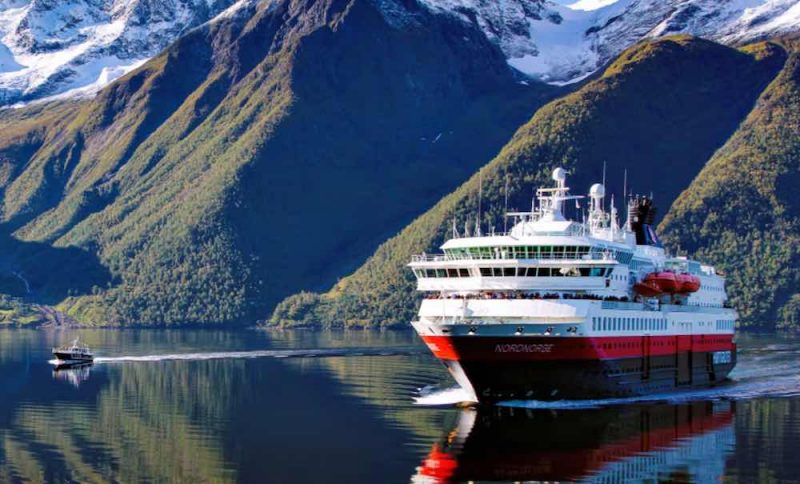Norwegian cruise and ferry company Hurtigruten has announced its plans to sail the Norwegian Coastal Express emission-free by 2030, announcing its plan to build a zero-emission vessel ready to sail by 2030.
The Hurtigruten Norwegian Coastal Express – which takes 12 days to travel from the southern city of Bergen, across the Arctic Circle, up to Kirkenes, and back again – is both a pleasure cruise and a local ferry, depending on your point of view. Having travelled the route since 1893, the Hurtigruten Norwegian Coastal Express carries local passengers, goods, and tourists, between 34 ports.
“We are excited to announce our most ambitious sustainability initiative to date; creating solutions for zero emission passenger ships, using the Norwegian coast as the ideal case,” said Daniel Skjeldam, Hurtigruten Group CEO.
“Our ambition is to sail an emission-free Hurtigruten Norwegian Coastal Express ship by 2030.”
The Hurtigruten Group is already upgrading its existing fleet in one of the biggest environmental upgrade programs of its kind in Europe and is expected to cut the company’s CO2 emissions by 25% and nitrogen oxide emissions by 80%.
Partnering with Norwegian research institute SINTEF, the Hurtigruten Group are setting out to design a new ship build program that will encompass everything from design, propulsion, energy, and fuel, through to hotel operations and digital solutions, with a goal to ensure the new ships are emission-free to both air and sea, as well as sustainable from a circular economy perspective.
“We have built our last fossil fuelled ship for the Norwegian Coastal Express,” said Hurtigruten Norway CEO Hedda Felin. “When we sail the coastal route for the next 100 years, it will be emission-free, making the world’s most beautiful voyage even more spectacular.
“We are proud to partner with SINTEF Ocean to pioneer the new solutions needed. In order to transform high ambitions into actual results, coupling our knowledge of the coast with SINTEF’s expertise is a key factor,” Felin said.
“With this project, Hurtigruten Norway and SINTEF can show the world that green and sustainable passenger ships can be achieved in the near future,” added SINTEF President Alexandra Bech Gjørv.
“Cutting emissions in the maritime sector is by no means an easy feat, and we need ambitious companies like Hurtigruten Norway to take initiatives like this.”
The Hurtigruten Norwegian Coastal Express will serve as the starting point for Hurtigruten’s larger transition to zero-emission passenger vessels, which will also see several ports planning to expand shore power connectivity. The Express will also provide the local ports with an opportunity to use planned green energy infrastructure for their own local needs.
“We as a group have ships sailing all over the world, and we see that the Norwegian coast is an ideal location for this kind of game changing project, where we can benefit from the innovative Norwegian expertise in green shipping,” said Skjeldam.
The first phase of the new ship build program undertaken between Hurtigruten and SINTEF has already begun with a feasibility study which will look at technological and operational solutions.
The second phase will invite leading maritime industry partners to participate in taking the project further towards development and qualification of innovative green ship designs and technologies.
Joshua S. Hill is a Melbourne-based journalist who has been writing about climate change, clean technology, and electric vehicles for over 15 years. He has been reporting on electric vehicles and clean technologies for Renew Economy and The Driven since 2012. His preferred mode of transport is his feet.

